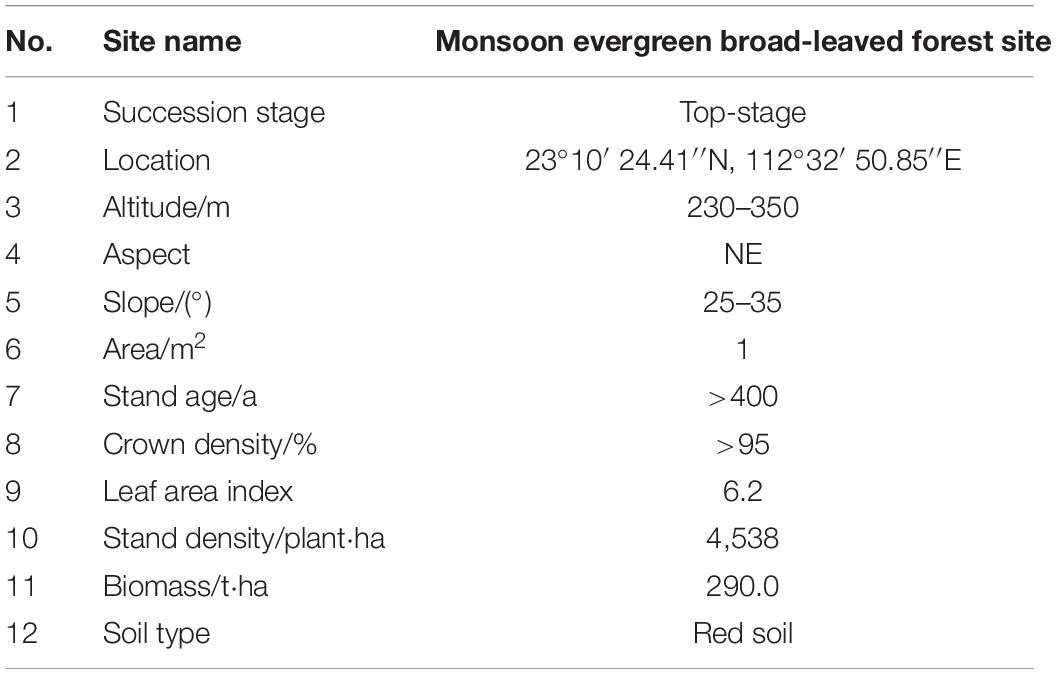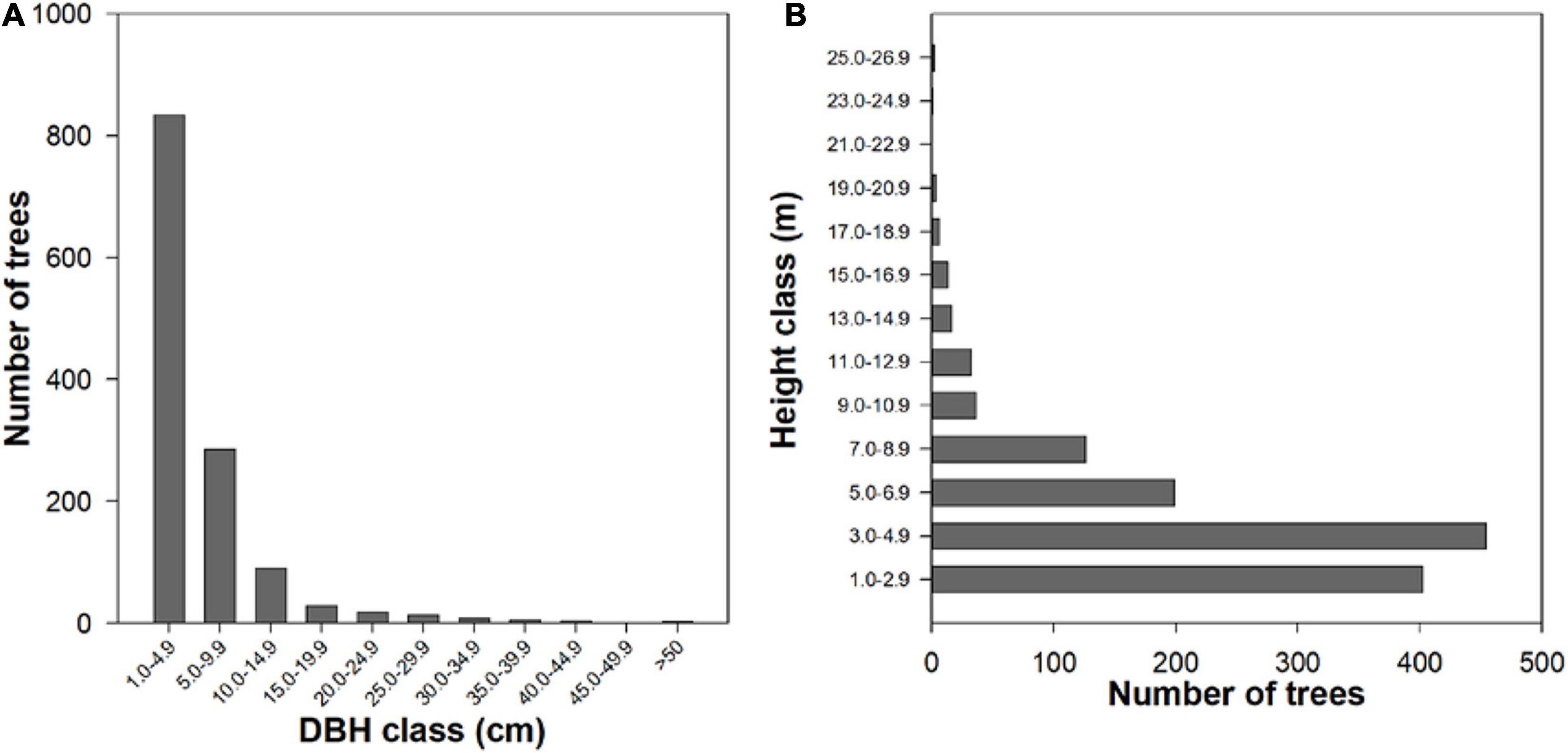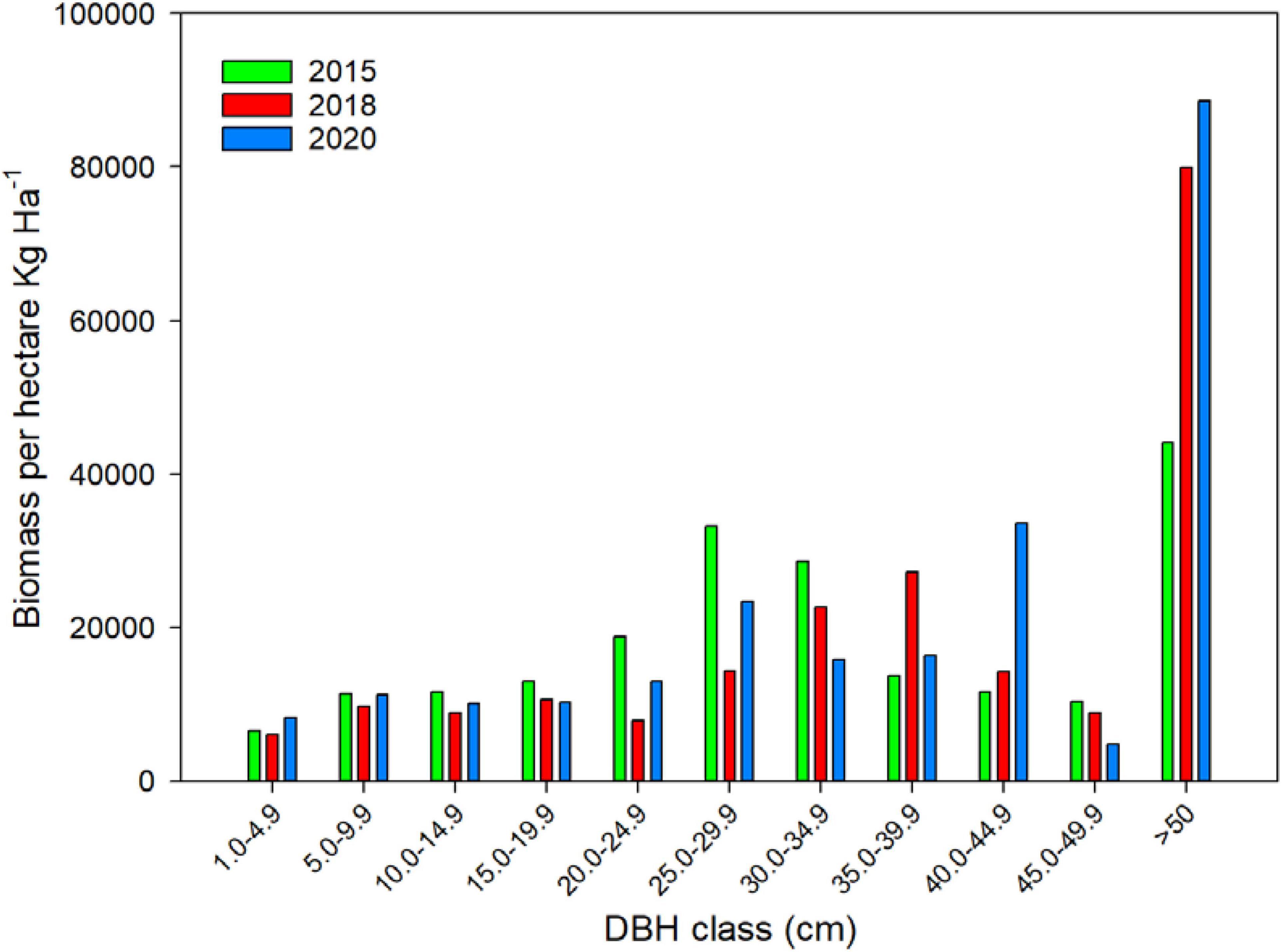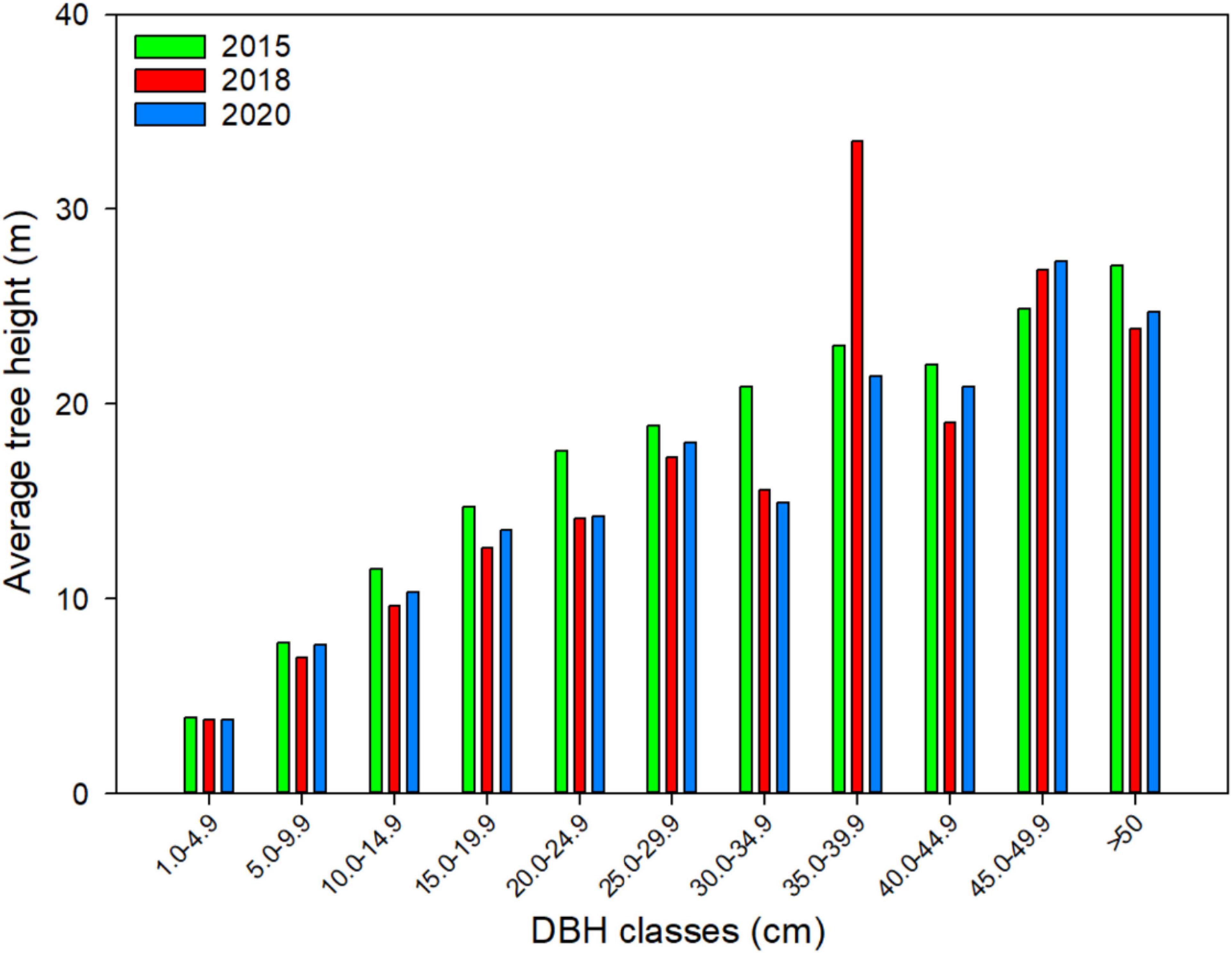- 1Core Botanical Gardens, Chinese Academy of Sciences, Guangzhou, China
- 2Key Laboratory of Vegetation Restoration and Management of Degraded Ecosystems, South China Botanical Garden, Chinese Academy of Sciences, Guangzhou, China
- 3University of Chinese Academy of Sciences, Beijing, China
- 4Guizhou Province Key Laboratory of Ecological Protection and Restoration of Typical Plateau Wetlands, Guizhou University of Engineering Science, Bijie, China
Sensitivity to climate change is one of the key features of the Dinghushan National Nature Reserve that is located in the lower subtropical China. Having faced typhoon Mangkhut in 2018, there emerged a need to study the effects that the typhoon had on the evergreen broad-leaved forest community in Dinghushan. The forest composition data for 2015, 2018, and 2020 was used in this study. The aim was to establish a scientific basis for the restoration of natural forests that have the ability to withstand strong weather phenomena such as typhoons and the hypothesis stated that typhoon Mangkhut had a long-term detrimental effect on the forest community in Dinghushan forest. The results showed that trees that have a DBH of less than 5 cm and a height of less than 2 m were more prone to damage during a severe weather events. In 2015, there was a total of 5,682 trees per hectare while in 2018 there was a total of 5,022 trees per hectare showing a decline in the number of trees per hectare of 660 due to the typhoon. Number of trees in each DBH class, height class, total above ground dry weight and average tree height was also lower in 2018 as compared to 2015 and 2020. The species abundance was also adversely affected with a loss of 672 species per hectare in 2018 compared to 2015. In 2020, about 83% of all trees had a DBH of less than 5 cm and an average height of 3.8 m making up a large proportion of trees that could be damaged if another storm occurred of similar or greater magnitude as the one that hit the region in 2018. Of interest was the forests remarkable ability to bounce back as there is an increase in biomass when 2018 is compared to 2020. The results support the hypothesis of the study. It is therefore of utmost importance that strategies be put in place to protect this ecosystem and others of a similar nature, by employing the use of natural forests that have great resilience against typhoons.
Introduction
Climate change is threatening tropical forest communities in a variety of ways, such as increasing the frequency of severe drought, large fires, storms, and flooding (Davidson et al., 2012). There are various scientific arguments on the relationship between typhoons and global climate change, but relevant studies support the fact that typhoons are closely related to global climate change. It has been demonstrated through climatic simulations that under the influence of climate change, the severity of typhoons will increase in frequency and magnitude especially in lower latitudes, such as the latitude where lower subtropical China is found, more than in higher latitudes, a prediction that puts evergreen broad-lived forests such as Dinghushan in direct harm’s way in future typhoon events that will inevitably occur (Takemi et al., 2016). As a natural disturbance factor, a typhoon has a short influence time but great destructive power. It not only has strong winds, but also brings a sharp increase in precipitation (Lin et al., 2011); it directly causes mechanical damage to the forest community, and affects the species composition and structure, water, litter, and soil nutrient cycling processes and ecosystem stability in the forest community (Kauffman and Cole, 2010; Wang et al., 2018). Tropical cyclones also have the capacity to cause canopy gaps of various scales that have an impact on understory light permeability and nutrient availability thus impacting forest regeneration and species composition, moreover, forests that have a high density such as Dinghushan experience greater damage due to a high ratio of tree height to diameter breast height and relatively weak roots (Liu et al., 2012). The deposition of large amounts of litterfall into the forest floor as a result of a typhoon has been recorded to increase nutrient availability such as P or K in the soil beyond normal amounts as the fresh vegetation fall contains more nutrients thus leading to a situation where the microorganisms and vegetation are unable to breakdown, absorb, and retain the nutrients in the ecosystem leading to nutrient loss through runoff and stream water (Liu et al., 2012; Peng et al., 2012; Lin K. C. et al., 2017). For a given stem diameter, trees that were shorter with dense and stiffer wood were found to be more likely to be uprooted while those with strong wood were more likely to be snapped during a storm (Putz et al., 1983). In the past two decades, many scientists have carried out extensive research on the impact of typhoons on forest communities (Lin et al., 2011; Lin K. C. et al., 2017). The impact of storm events on vegetation has also been systematically studied all over the world. In the Caribbean for example, hurricanes have been found to impact ecosystems and alter the structure of plant and animal communities (Walker et al., 1991). The impact of a typhoon on forests in Australia has also been studied and the effects documented (Bellingham, 2008). China is one of the main countries affected by typhoons, with frequent typhoons along the southeast coast, especially in Hainan. For the tropical forest in Hainan, a typhoon affects the redistribution of rainstorms, causing changes in hydrological function, mechanical damage of the forest community, increased litter and increased soil loss (Xu et al., 2008; Liu et al., 2012). In China, however, the impact of a typhoon on the subtropical monsoon evergreen broad-leaved forest community has not been reported, and the research on typhoons in China is less developed compared to other natural disasters such as fire and drought.
The super typhoon “Mangkhut” that occurred on September 16, 2018 had a profound impact on the forest ecosystem of Dinghushan Nature Reserve, especially as it is a monsoon evergreen broad-leaved forest. The occurrence of the typhoon led to a large number of fallen trees, broken branches, and fallen leaves. Long term monitoring of vegetation favored the studying of the influence of a typhoon on the monsoon evergreen broad-leaved forest systematically and comprehensively in lower subtropical China. In this study, the vegetation composition and structure of a monsoon evergreen broad-leaved forest before and after the typhoon were compared and analyzed, to find out the community structure and species diversity change law, analyze the impact factors of wind fallen trees and the impact of a typhoon on tropical forest biomass and carbon return processes. The study aimed to provide a scientific basis for vegetation restoration of natural forests that are composed of strong wind resistant tree species in typhoon prone areas and degraded natural forests by monitoring the long-term dynamic changes of community characteristics of monsoon evergreen broad-leaved forests. The hypothesis tested in this study was, Typhoon Mangkhut had a long term detrimental impact on forest community structure in Dinghushan forest. This study will be helpful in improving the ability to deal with natural disasters in the future and to study the impact of typhoons on vegetation in connection to the possible extreme climate events under the situation of global climate change.
Materials and Methods
Study Site Description
Dinghushan National Nature Reserve (23°09′21″–23°11′30″N, 112°30′39″–112°33′41″E) is located in Dinghu District, Zhaoqing City, Guangdong Province, covering a total area of 1,155 ha. The main terrain is made up of hills and low mountains, with an elevation of 100–700 m. The area has a south subtropical monsoon climate, with an annual rainfall of 1,714 mm and an average annual humidity of 76%. The wet season is from April to September, and the dry season is from October to March. The wet season rainfall accounts for about 80% of the annual precipitation. The average annual temperature is 22.5∘C, the average temperature of the coldest month (January) and the hottest month (July) is 13.8 and 28.8∘C. The geological basis is mainly Devonian sandstone, sand shale, shale and quartz sandstone, and the zonal soil is southern subtropical lateritic red soil (Zou et al., 2018). The plant community in Dinghushan is evergreen all the year round, and the canopy density is about 95%. According to the succession of the forest ecosystem, the plant community in Dinghushan can be divided into masson pine coniferous forest in the early stage of succession, coniferous, and broad-leaved mixed forest in the middle stage of succession and monsoon evergreen broad-leaved forest in the late stage of succession. Monsoon ever-green broad-leaved forest, close to the Buddhist temple, is distributed in the core area of the reserve and has not been disturbed for more than 400 years. A series of studies was done to demonstrate that the forest has not been disturbed for that long (Zhou et al., 2013). The main species in the tree layer of monsoon evergreen broad-leaved forest are Castanopsis chinensis, Schima superba, Cryptocarya concinna, Cryptocarya chinensis, Gironniera subaequalis, Macarashell cnga sampsonii, Aidia canthioides, etc. (Zou et al., 2018). To investigate the long-term impacts of climate change and human activities on ecological resilience, biodiversity, and ecosystem services, a long-term monitoring project on the dynamics of monsoon evergreen broadleaved forest began in 1978. And a 1-ha permanent monitoring site in the monsoon evergreen broad-leaved forest was established. The well-preserved monsoon evergreen broad-leaved forest suffered from the typhoon Mangkhut heavily in 2018, the landscape of the site before and after the typhoon are shown in Figure 1. Based on the old monitoring data, brief description of the permanent site is shown in Table 1 (Zhang, 2011; Zhou et al., 2013, 2014).
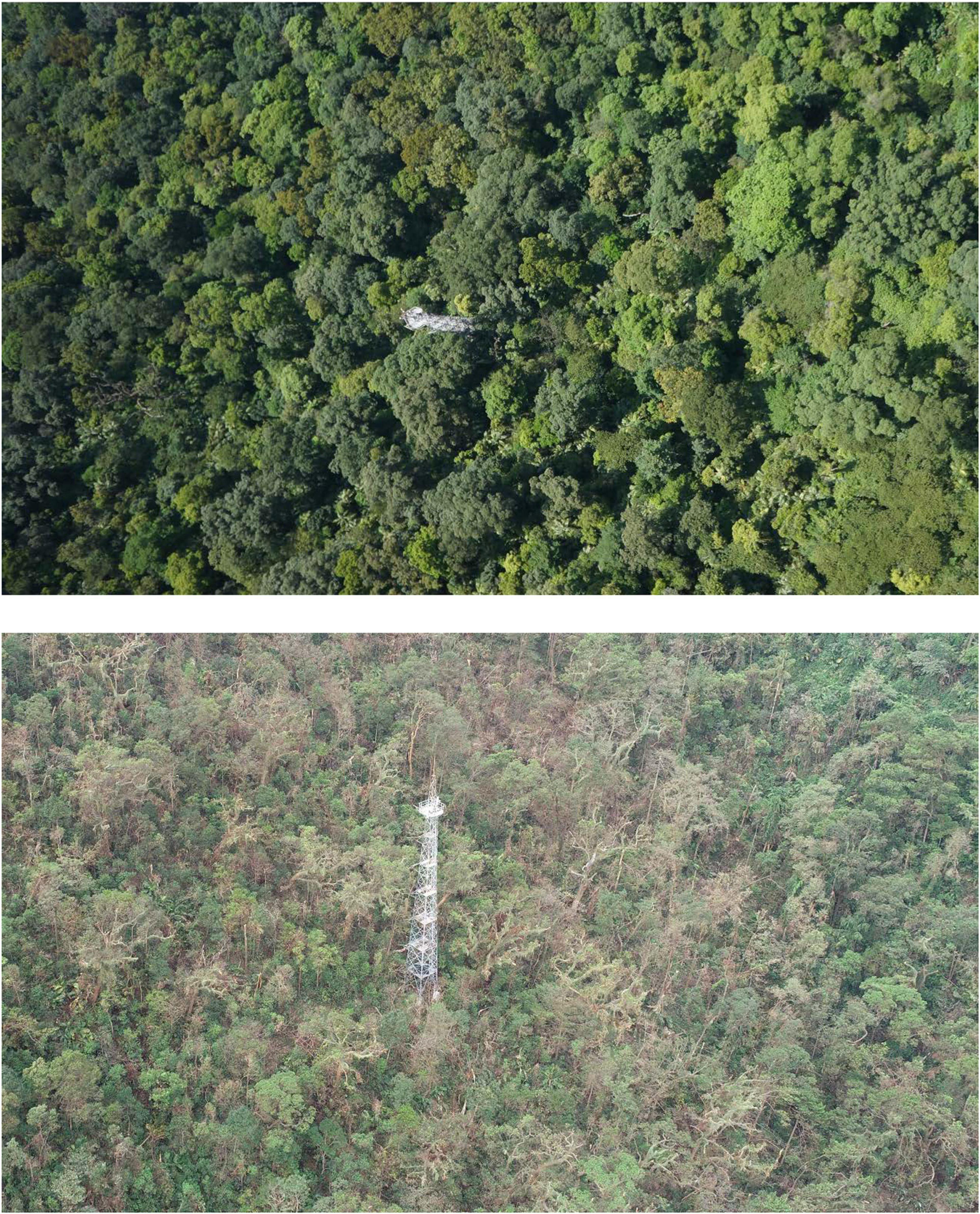
Figure 1. The landscape of the site, the upper plate showed before typhoon Mangkhut (September 2016), and the lower plate showed after (September 2018).
Methods
Community Surveys
We surveyed the tree community since 1978, the data collection of this study was surveyed in 2015, 2018, and 2020. All individuals with a diameter at breast height (DBH at 1.3 m above the ground) ≥ 1 cm and a height ≥ 1.5 m in the permanent sample plot were labeled, during the measurement period, all individuals were accurately traced. The difference between 2015 and 2018, resulting from the typhoon, was an area of focus during the data collection procedures and we also emphasized the data collected in 2018 and 2020 in our analysis for post-typhoon community structure survey. To facilitate comparisons, we classified all individuals into four classes based on diameter at breast height (DBH): 1 ≤ DBH ≤ 5 cm, 5 < DBH ≤ 10 cm, 10 < DBH ≤ 20 cm, and DBH > 20 cm). According to the protocols for standard biological observation and measurement in terrestrial ecosystems (Committee of Chinese Ecological Research Network, 2019), the unified methods were applied to community field survey and biomass calculation (Sam, 1973). The detailed field survey date were November, 2015, 2018, and October, 2020.
Statistical Analysis
The statistical analysis was done using Sigma Plot for Windows version 14.0 Build 14.0.0.124. Data derived from 100 10 × 10 m plots was divided into DBH classes and clustered into 2018 and 2020 equivalent variants for variable analysis. Descriptive statistics as well as graphical analysis were used for the quantitative analysis of the data. Linear and non-linear correlation was performed using standard and polynomial quadratic curve functions. The slopes of the regression that had an R square value of >0.7 and a p-value of <0.05 were accepted as statistically significant.
Results
Tree Damage Analysis in 2018 as a Result of Typhoon Mangkhut
Trees that had a DBH of less than 5 cm and a height of less than 2 m were most likely to be destroyed in a storm as shown in Figures 2A,B; this may perhaps be because of how feeble these small trees were lacking the structure and vigor to anchor to the soil when a large storm hits. Figures 2A,B clearly illustrates that any tree that had a DBH of less than 10 cm and a height of less than 10 m suffered damage or even complete destruction in the presence of a large storm. It is, however, counter-intuitively to note that taller trees that had a height of greater than 20 m and a DBH of more than 20 cm faced minimal damage in a storm despite having a large surface area of their above ground foliage exposed to the elements a situation that may have had something to do with their greater capacity to anchor deep into the soil using their larger roots and therefore withstand a storm with minimal damage.
Out of the 1,290 recorded damaged trees in Dinghushan forest, only five trees that had a height of 20 m or above were damaged and only seven that had a DBH of greater than 40 cm were damaged with Canarium album (Loureiro) Raeuschel and Castanopsis chinensis (Spreng.) (Table 5) hence being the only two large trees that had damage inflicted on them by the storm a fact that probably had to do with their structure or how firmly they anchored to the soil and how deep their roots grew. As a whole, there were 1,290 damaged trees (25.71%) and 488 fallen trees (9.73%) making up a total of 5,017 trees per hectare affected by the storm in 2018.

Table 2. Data on the number, tree height, above ground weight, and below ground weight of Dinghushan forest station in the year 2015 divided into DBH classes.

Table 3. Data on the number, tree height, above ground weight, and below ground weight of Dinghushan forest station in the year 2018 divided into DBH classes.

Table 4. Data on the number, tree height, above ground weight, and below ground weight of Dinghushan forest station in the year 2020 divided into DBH classes.
DBH classes of less than 5 cm had the highest number of fallen trees per hectare (Figure 3A). The average DBH of fallen trees was 9.38 cm while the tree with the largest DBH that fell was 35.4 cm with Blastus cochinchinensis Lour. having a height classes of between 2 and 5 m having the highest number of fallen trees per hectare (Table 5). The average height of a fallen tree was 8.89 m whereas the tallest tree that fell was 20 m belonging to Pygeum topengii Merr species. DBH and the height of a tree therefore had role in determining whether a tree would fall during a typhoon in Dinghushan forest. Macaranga sampsonii Hance had the highest number of fallen trees at a count of 127 per hectare with an average DBH of 3.5 cm and an average height of 4.65 m followed by Blastus cochinchinensis Lour. with 99 fallen trees per hectare having an average height of 4.86 m and a DBH of 3.89 cm (Table 5). In general, shorter trees of less than 5 m in height with a small DBH of less than 5 cm had a greater probability of falling during a typhoon or strong storm in Dinghushan forest.
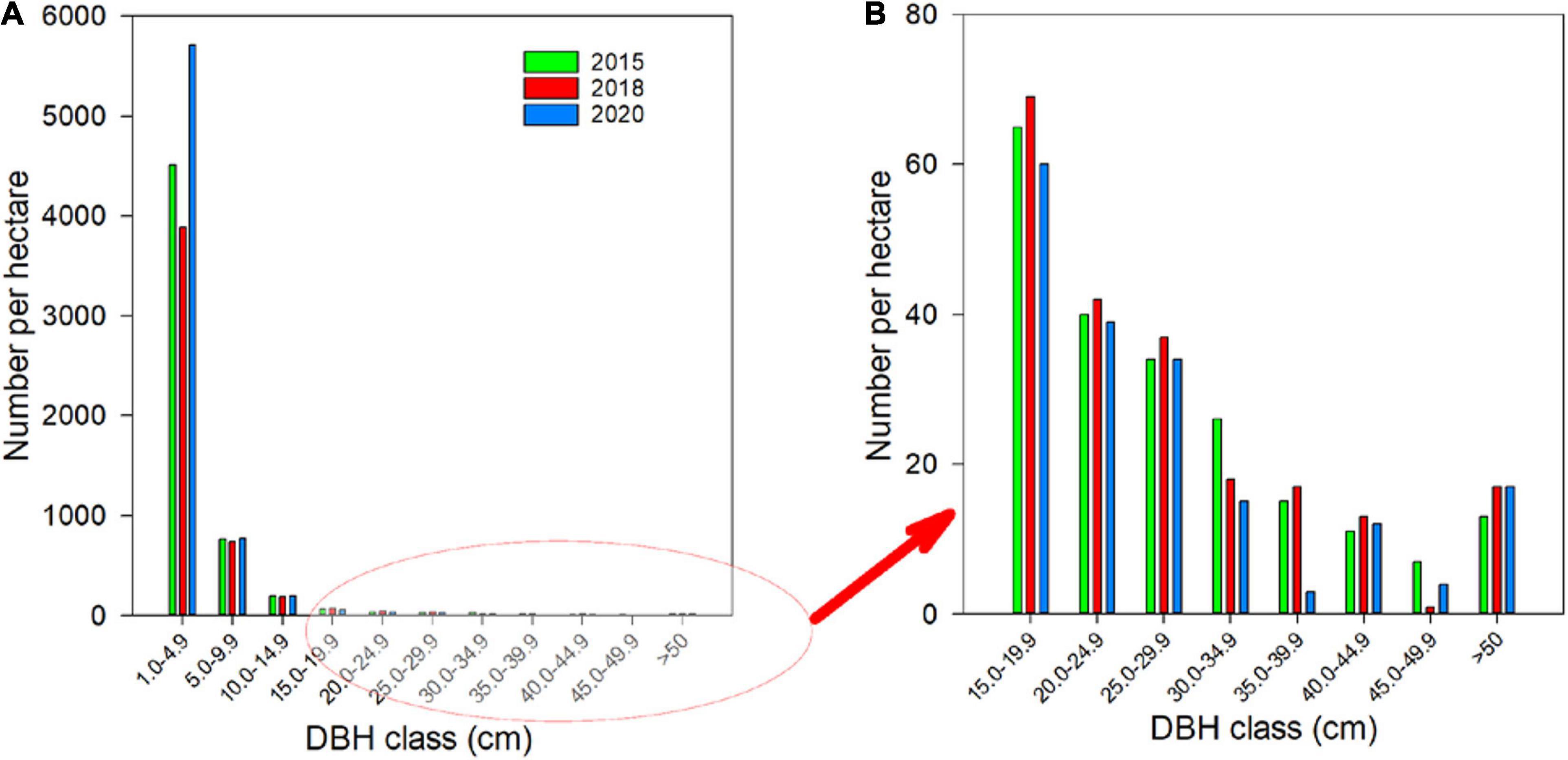
Figure 3. Number of trees in each DBH class per hectare in 2015, 2018, and 2020 (A) all DBH classes, (B) 15 to >50 cm DBH class.
Statistical and Analytical Comparisons of Dinghushan Forest Composition in 2015, 2018, and 2020
In 2015 there was a total of 5,682 trees per hectare (Table 2) while in 2018 there was a total of 5,022 trees per hectare (Table 3) showing a decline in the number of trees per hectare of 660. In 2020, about 83% of all trees had a DBH of less than 5 cm and an average height of 3.8 m (Table 4) making up a large proportion of trees that could be destroyed or damaged if another storm occurred of similar or greater magnitude as the one that hit the region in 2018. Table 3 illustrates clearly a decline in number of trees and above ground biomass as compared to Table 4 partly as a result of the storm that hit the forest in 2018. Trees with a DBH of less than 5 cm made up the majority of the plants within the area in Dinghushan forest (Figure 2); within this DBH of less than 5, there were a total of 4,510 trees per hectare making up 79.37% of all trees in 2015, 3,886 trees per hectare making up 77.38% of all the trees in 2018 and 5,713 trees per hectare making up 83% in 2020 (Tables 2–4) thus illustrating the potential that Dinghushan forest has both to thrive when the conditions allow and at the same time to be heavily damaged in a storm.
Figure 3 shows a lower population of trees in 2018 compared to 2015 and 2020 in the 1–5 cm DBH classes illustrating their vulnerability to a severe storm or typhoon. Trees with a larger DBH of greater than 25 cm are shown to have fared on well despite the typhoon perhaps their larger physiological structures helped them withstand the typhoon better than their smaller counterparts. In Figure 4, the number of trees per hectare are displayed according to their height. The year 2018 repeatedly had fewer individual trees per hectare as compared to both 2015 and 2020 illustrating the effect the typhoon had on the Dinghushan ecosystem with even the taller trees with a height greater than 27 m being adversely affected and reducing in number.
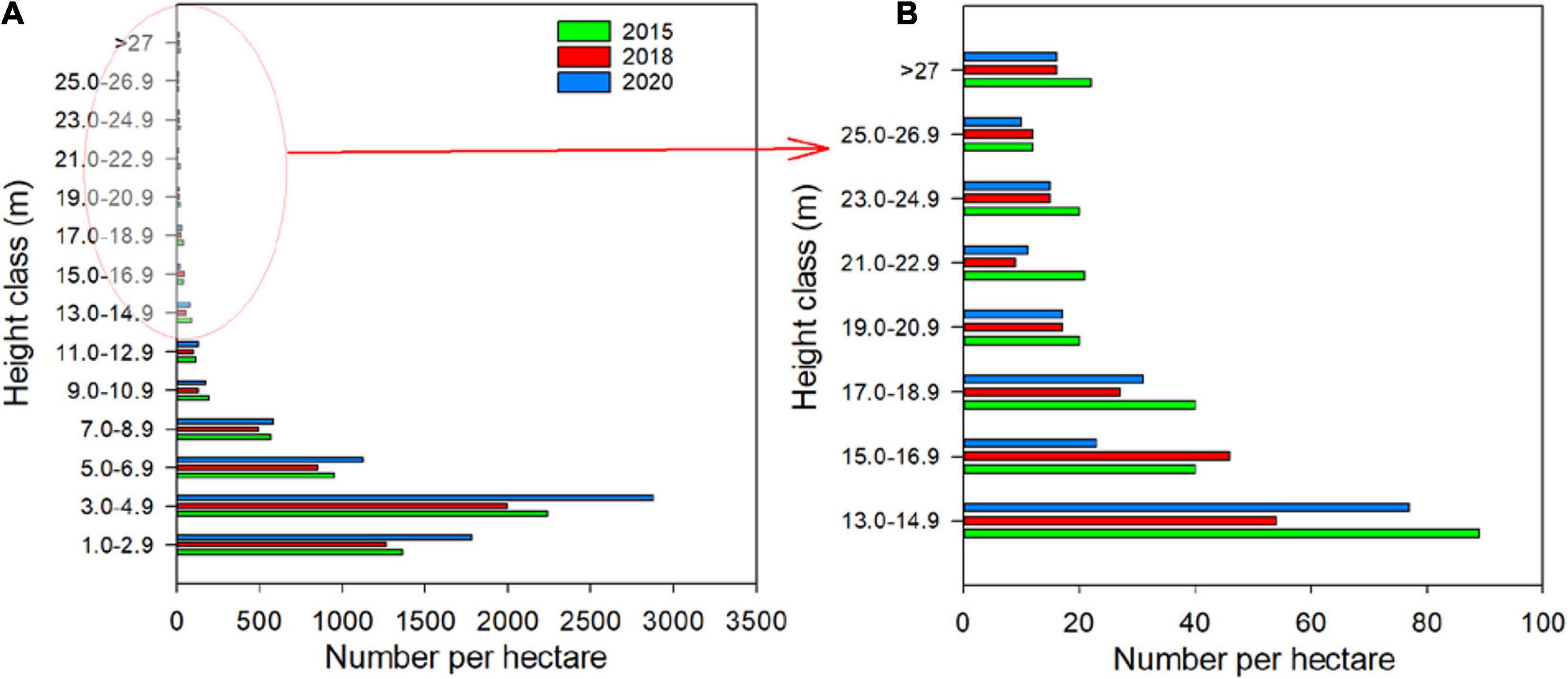
Figure 4. Number of trees per hectare in each height class in 2015, 2018, and 2020 (A) all height classes, (B) 13 to <27 m height class.
Biomass per hectare was consistently lower in the year 2018 as shown on Figure 5 with only one DBH class (35–39.9 cm) being higher than the rest of the years being compared in the study. The ability of Dinghushan forest to bounce back after facing a destructive weather event such as a typhoon is illustrated in Figure 5 as well. Even though the total above ground biomass is lower in 2018 just after the storm hit the forest, the forest quickly recovers and the increases is reflected in Tables 2–4 and Figure 5.
Tree height was also affected by the typhoon in 2018 because the height of trees per DBH class in 2015 and in 2020 was higher except only in one DBH class (35–39.9 cm) which was higher than expected (Figure 6). This result shows that in general, typhoons and storms impact tree height resulting in on average shorter trees in every DBH class. Linking to the physical damage, after the typhoon, the community structure changed significantly, with 1,290 damaged trees (25.71%) and 488 fallen trees (9.73%).
Species Composition Analysis in Dinghushan Forest in 2015, 2018, and 2020
We found dominant species including Cryptocarya concinna Hance, Lasianthus chinensis (Champ.) Benth., Meliosma rigida Siebold et Zucc., Pygeum topengii Merr., Schima superba, Gardner et Champ., Sterculia lanceolata Cav., and Syzygium levinei (Merr.) Merr. et L. M. Perry were resilient tree species against a strong storm, and therefore they did not easily fall down in spite of the typhoon as illustrated in Figure 7B. On other hand, Blastus cochinchinensis Lour., Cryptocarya chinensis (Hance) Hemsl., Gironniera subaequalis Planch., Macaranga sampsonii Hance, Mallotus paniculatus (Lam.) Müll. Arg., Pterospermum lanceifolium Roxb. were non-wind resistant tree species (Figure 7A). The tree fall of the non-wind resistant tree species contributed 9.37% of the total biomass returned to soil.
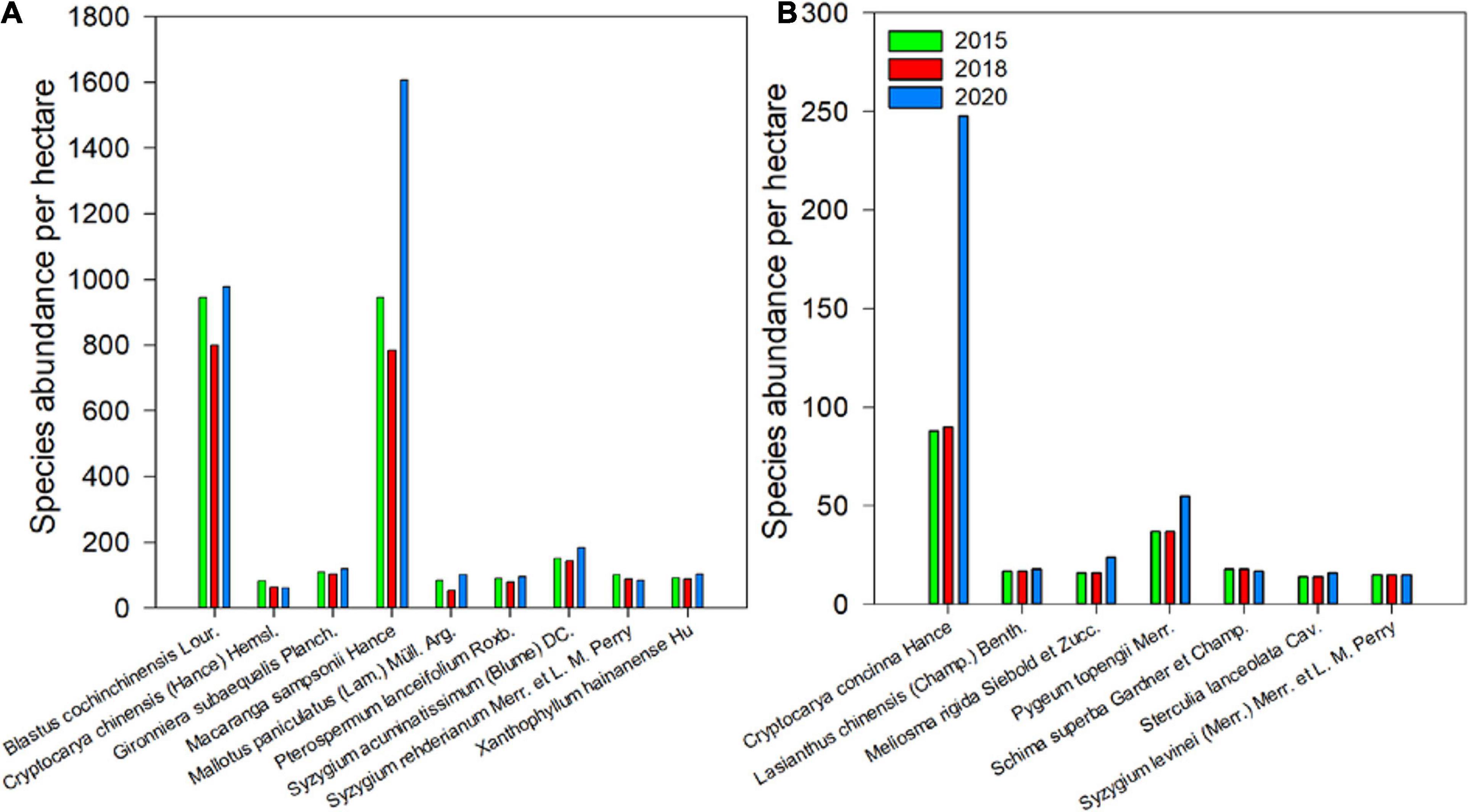
Figure 7. Species abundance in (A) species most affected by the typhoon (B) Species least affected by the typhoon.
The total average biomass, number of species and species abundance was lower in 2018 as compared to both 2015 and 2020 as shown in Figures 7A,B. The biomass was 192,584.5474 kg ha–1 in 2015, 188,487.1375 kg ha–1 in 2018, and 236,131.0484 kg ha–1 in 2020 numbers that give a glimpse of the destruction and loss experienced in the forest during the typhoon. The species abundance was also adversely affected with a loss of 672 species per hectare compared to 2015 and a gain of 1,851 species per hectare compared to the year 2020 (Figure 7B). The findings illustrated when observed in their totality, support the hypothesis that typhoon Mangkhut did have a long-term detrimental impact on the forest community in Dinghushan forest.
Discussion and Conclusion
Effects of Typhoon on Community Composition and Structure and Physical Environment in the Forests
In this study, we found that effects of typhoon Mangkhut on the Dinghushan monsoon evergreen broad-leaved forest community were multi-faceted. Firstly, small trees with a DBH of less than 5 cm and a height of less than 2 m experienced the greatest damage due to the typhoon (Figures 2A,B). A large number of fallen trees, broken branches and fallen leaves were produced in the forest after the typhoon, which led to the decrease of canopy density, thus enhancing light transmittance and produced a large number of gaps (Table 5), a result that agrees with the findings of Lin et al. (2011) and Tang and Zhou (2005). In agreement with Xu et al. (2008), Dinghushan forest also exhibited a strong gap edge effect, as inferred from the results, meaning the community structure response to the typhoon showed the importance of gaps for regeneration of trees and maintenance of species diversity as shown in Figures 8A–C.
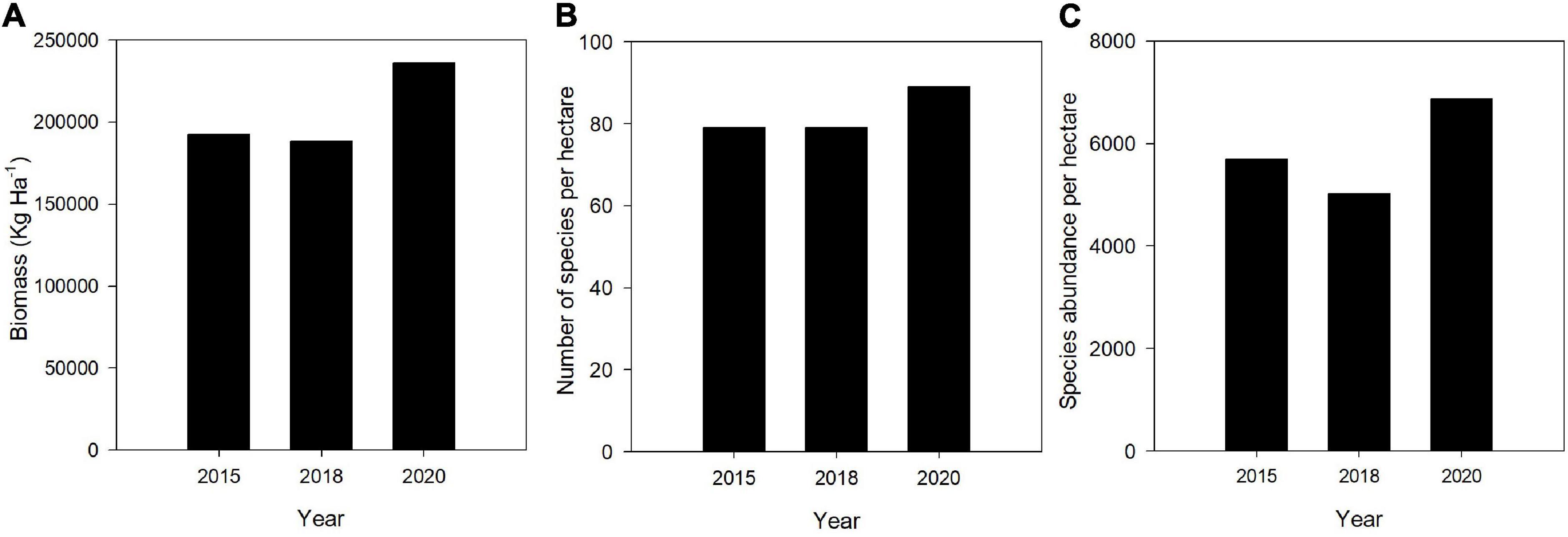
Figure 8. A comparison between (A) Biomass, (B) Number of species per hectare, and (C) Species abundance per hectare in 2015, 2018, and 2020.
Comparisons of Community Structure Between 2015, 2018, and 2020
The response of community composition and structure to a typhoon, differed from what has been reported in southern China perhaps due to climate change thus, when big trees fell down, it was observed that young trees grew up very fast in the two coming years (Figures 3, 4). The number of individuals per unit area also increased significantly, but the number of species did not increase significantly as the data for the year 2020 suggests (Figures 8B,C).
The microclimate environment in the forest also changed to some extent. In this case, considering community composition and structure change, as reported by many researchers, the forest density is getting higher with many seedlings flourishing because the forest gaps provide growth opportunities for regenerating individuals (Walker et al., 1991; Peng et al., 2012; Chi et al., 2015) as illustrated in Figures 3, 4. A study conducted in Panama by Putz et al. (1983) recorded that trees that have a smaller DBH and a shorter height sprouted faster after damage as a way of compensating for their susceptibility to snapping or mechanical damage and this observation agrees with the findings at Dinghushan that show that after the typhoon, smaller trees bounced back faster and contributed significantly to the ecosystem recovery (Figures 3, 4). Canopy openness as a result of disturbance has been recorded to have a larger impact on a forest ecosystem more than debris deposition with a tremendous change in ferns, woody plant and understory herbivory (Shiels et al., 2014) and this was also observed in Dinghushan particularly after the typhoon more so in the year 2020. On the other hand, after the typhoon, the species composition and spatial distribution pattern of the population changed, leading to the change of species diversity (Figure 8C), due to the vertical structure of the forest changing, the arbor layer was changed significantly. Other studies have recorded that a tree’s lifespan is significantly affected by floods or mudslides that happen during and after a typhoon (Tzeng et al., 2018) and this factor needs further investigation in Dinghushan forest. In our results, we highlighted the effect typhoon Mangkhut had on tree height, however, Lin C. et al. (2017) warns that caution should be observed when interpreting maximum tree height as a consequence of environmental harshness (Figure 6) and instead suggests this metric be applied mostly in regions that have frequent disturbances on tree height. Tree species that were recorded to be resistant to typhoon induced disturbance suggest that they possess certain adaptations that other trees lack, however, with climate change and an intensification of tropical cyclones, these adaptations may not be as effective in the years to come and therefore such tree species need further studies to safeguard their sustainability and the carrying forward of these advantageous traits. Owing to observation time limit, we didn’t explore how different layers respond to a typhoon effect, but based on the long-term forest monitoring, the research on community succession direction and long-term adaptive response of different plant species will be explored further in the future.
The results suggest that at least 9.37% biomass returned to the forest floor after Typhoon Mangkhut (Figure 8A), which greatly influenced the carbon cycle of the forest ecosystem. Old-growth forests have traditionally been considered negligible as carbon sinks because carbon uptake has been thought to be balanced by respiration. The monsoon evergreen broad-leaved forest community in Dinghushan Nature Reserve is an old-growth forest in lower subtropical China. Previous studies in Dinghushan have shown that old-growth forests can accumulate carbon in soils (Zhou, 2006). While under the influence of the typhoon, a lot of biomass returned to soil, this rapid return leads to the acceleration of carbon cycle and the redistribution of carbon storage in different spaces of forest environment. The recovery degree of its carbon sequestration capacity and the recovery time needed are still unclear in the case of Dinghushan forest, and further long-term fixed monitoring is needed. The impact of typhoon Mangkhut on the forest community of Dinghushan is clear, testable, and overall detrimental thus, supporting the hypothesis of the study. Having got a clear understanding of the impact of a typhoon on an evergreen broad-leaved forest from this study, if we only account of forest carbon sequestration, Cryptocarya concinna Hance, Lasianthus chinensis (Champ.) Benth., Meliosma rigida Siebold et Zucc., Pygeum topengii Merr., Schima superba Gardner et Champ., Sterculia lanceolata Cav., and Syzygium levinei (Merr.) Merr. et L. M. Perry might be the right afforestation species in the face of typhoon pressure.
Data Availability Statement
The raw data supporting the conclusions of this article will be made available by the authors, without undue reservation.
Author Contributions
YL, BM, QZ, JL, SW, ZL, and TW: data process. YL, BM, and JL: writing. SZ and CW: data analysis. SL and GC: data collection. SL: vegetation investigation. XT and DZ: experimental design. ZM: site maintenance. All authors contributed to the article and approved the submitted version.
Funding
This work was funded by the National Natural Science Foundation of China (31961143023, 31670453, and 41430529); The National Science and Technology Basic Work Project (Grant No. 2015FY1103002); Dinghushan Forest Ecosystem Positioning Research Station of the National Science and Technology Infrastructure Platform, Chinese Ecosystem Research Network (CERN); and by Operation Service Project of National Scientific Observation and Research Field Station of Dinghushan Forest Ecosystem in Guangdong, Ministry of Science and Technology of the People’s Republic of China.
Conflict of Interest
The authors declare that the research was conducted in the absence of any commercial or financial relationships that could be construed as a potential conflict of interest.
References
Bellingham, P. J. (2008). Cyclone effects on Australian rain forests: an overview. Austr. Ecol. 33, 580–584. doi: 10.1111/j.1442-9993.2008.01914.x
Chi, C. H., Mcewan, R. W., Chang, C. T., Zheng, C., and Lin, T. C. (2015). Typhoon disturbance mediates elevational patterns of forest structure, but not species diversity, in humid monsoon Asia. Ecosystems 18, 1410–1423. doi: 10.1007/s10021-015-9908-3
Committee of Chinese Ecological Research Network (2019). Protocols for Standard Biological Observation and Measurement in Terrestrial Ecosystems. Beijing: China Environmental Science Press.
Davidson, E. A., Araujo, A., and Artaxo, P. (2012). The Amazon basin in transition. Nature 481, 321–328.
Kauffman, J. B., and Cole, T. G. (2010). Micronesian mangrove forest structure and tree responses to a severe typhoon. Wetlands 30, 1077–1084. doi: 10.1007/s13157-010-0114-y
Lin, C., Wang, L., Zheng, C., McEwan, R., Chang, C., Chiang, J., et al. (2017). Tropical cyclones disrupt the relationship between tree height and species diversity. Ecosphere 8:e01938. doi: 10.1002/ecs2.1938
Lin, K. C., Hamburg, S. P., Wang, L., Duh, C. T., Huang, C. M., Chang, C. T., et al. (2017). Impacts of increasing typhoons on the structure and function of a subtropical forest: reflections of a changing climate. Sci. Rep. 7:4911. doi: 10.1038/s41598-017-05288-y
Lin, T. C., Hamburg, S. P., Lin, K. C., Wang, L. J., Chang, C. T., Hsia, Y. J., et al. (2011). Typhoon disturbance and forest dynamics. Ecosystems 14, 127–143. doi: 10.1007/s10021-010-9399-1
Liu, B., Pan, L., and Xue, L. (2012). A review of the effect of typhoon on forests. Acta Ecol. Sin. 32, 1596–1605. doi: 10.5846/stxb201012231832
Peng, S. L., Wang, Y. H., You, W. H., Liu, P. S., and Wen, Z. Z. (2012). Effects of typhoon storm on hydrological process and nutrient transportation of coastal forest. Hubei Agricult. Sci. 51, 4381–4383.
Putz, F. E., Coley, P. D., Lu, K., Montalvo, A., and Aiello, A. (1983). Uprooting and snapping of trees: structural determinants and ecological consequences. Canad. J. For. Res. 13, 1011–1020. doi: 10.1139/x83-133
Sam, D. (1973). The integration of fieldwork and survey methods. Am. J. Sociol. 78, 1335–1359. doi: 10.1086/225467
Shiels, A. B., Grizelle, G., and Michael, R. W. (2014). Responses to canopy loss and debris deposition in a tropical forest ecosystem: synthesis from an experimental manipulation simulating effects of hurricane disturbance. For. Ecol. Manag. 260, 2214–2223.
Takemi, T., Ito, R., and Arakawa, O. (2016). Effects of global warming on the impacts of Typhoon Mireille (1991) in the Kyushu and Tohoku regions. Hydrol. Res. Lett. 10, 81–87, (Omitted). doi: 10.3178/hrl.10.81
Tang, X. L., and Zhou, G. Y. (2005). Coarse wood debris biomass and its potential contribution to the carbon cycle in successional subtropical forests of southern China. Acta Phytoecol. Sinica 29, 559–568. doi: 10.17521/cjpe.2005.0075
Tzeng, H., Wang, W., Tseng, Y., Chiu, A., Kuo, C., and Tsai, T. (2018). Tree mortality in response to typhoon-induced floods and mudslides is determined by tree species, size, and position in a riparian Formosan gum forest in subtropical Taiwan. PLoS One 13:e0190832. doi: 10.1371/journal.pone.0190832
Walker, L. R., Brokaw, N. V. L., Lodge, D. J., and Waide, R. B. (1991). Ecosystem, plant, and animal responses to hurricanes in the Caribbean. Biotropica 23, 313–521.
Wang, Q., Yu, D., Li, Z., and Wang, L. (2018). The effect of typhoons on the diversity and distribution pattern of aquatic plants on hainan island, South China. Biotropica 40, 692–699. doi: 10.1111/j.1744-7429.2008.00430.x
Xu, H., Li, Y. D., Luo, T. S., Lin, M. X., Chen, D. X., Mo, J. H., et al. (2008). Influence of typhoon Damrey on the tropical montane rain forest community in Jianfengling, Hainan island, China. J. Plant Ecol. 32, 1323–1334.
Zhang, Q. (2011). China Ecosystem Positioning Observation and Research data set Forest Ecosystem Volume Guangdong Dinghushan Station: 1998-2008. Beijing: China Agricultural Publishing House.
Zhou, G. Y. (2006). Old-growth forests can accumulate carbon in soils. Science 314, 1417–1417. doi: 10.1126/science.1130168
Zhou, G., Houlton, B. Z., Wang, W., Huang, W., Xiao, Y., Zhang, Q., et al. (2014). Substantial reorganization of China’s tropical and subtropical forests: based on the permanent plots. Glob. Change Biol. 20, 240–250. doi: 10.1111/gcb.12385
Zhou, G., Peng, C., Li, Y., Liu, S., Zhang, Q., Tang, X., et al. (2013). A climate change-induced threat to the ecological resilience of a subtropical monsoon evergreen broad-leaved forest in southern China. Glob. Change Biol. 19, 1197–1210. doi: 10.1111/gcb.12128
Keywords: Dinghushan Nature Reserve, typhoon Mangkhut, community composition and structure, biomass, monsoon evergreen broad-leaved forest
Citation: Li Y, Mwangi B, Zhou S, Liu S, Zhang Q, Liu J, Chu G, Tang X, Zhang D, Wei S, Lie Z, Wu T, Wang C, Yang G and Meng Z (2021) Effects of Typhoon Mangkhut on a Monsoon Evergreen Broad-Leaved Forest Community in Dinghushan Nature Reserve, Lower Subtropical China. Front. Ecol. Evol. 9:692155. doi: 10.3389/fevo.2021.692155
Received: 07 April 2021; Accepted: 04 May 2021;
Published: 31 May 2021.
Edited by:
Wenxing Long, Hainan University, ChinaReviewed by:
Otieno O. Dennis, University of Bayreuth, GermanyWenhua Xiang, Central South University Forestry and Technology, China
Copyright © 2021 Li, Mwangi, Zhou, Liu, Zhang, Liu, Chu, Tang, Zhang, Wei, Lie, Wu, Wang, Yang and Meng. This is an open-access article distributed under the terms of the Creative Commons Attribution License (CC BY). The use, distribution or reproduction in other forums is permitted, provided the original author(s) and the copyright owner(s) are credited and that the original publication in this journal is cited, in accordance with accepted academic practice. No use, distribution or reproduction is permitted which does not comply with these terms.
*Correspondence: Yuelin Li, eXVlbGluQHNjaWIuYWMuY24=
 Yuelin Li
Yuelin Li Brian Mwangi1,2,3
Brian Mwangi1,2,3 Ting Wu
Ting Wu Chen Wang
Chen Wang